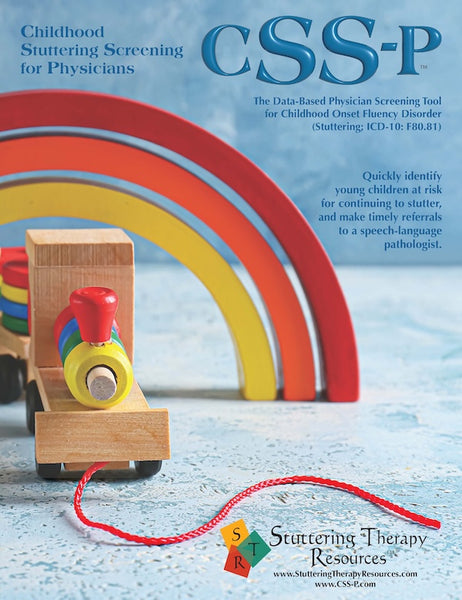Childhood Stuttering Screening for Physicians (CSS-P™)
 ™
™What Is the Childhood Stuttering Screening for Physicians (CSS-P™)?
- The CSS-P is a data-based screening tool for Childhood-Onset Fluency Disorder (ICD-10: F80.81) that indicates when physicians should refer children who stutter, ages 2 to 5, to a speech-language pathologist (SLP) for evaluation and possible treatment.
Why Screen Young Children Who Stutter?
- Many young children exhibit stuttering as they are learning to speak. Estimates of incidence for ages 2 to 5 range to 11%.
- Although most children stop stuttering, roughly 20-25% continue to stutter into the school-age years and beyond.
- Continued stuttering is associated with negative consequences including bullying and reduced quality of life.
- Early intervention increases the likelihood that a child will be able to speak more easily and minimize negative impact.
- Decades of research have identified "risk factors" that indicate whether a child is likely to continue stuttering.
- Children who exhibit these factors should be evaluated by an SLP to determine if they need specialized treatment to support their speech production, general speech and language development, and overall communication abilities.
What Is Stuttering?
- All speakers exhibit disruptions in their speech. These disruptions are known as speech disfluencies. Some speech disfluencies reflect stuttering behavior, but some do not.
- Stuttering behaviors are speech disfluencies that occur when people know what they want to say but cannot say it in that moment. This is different from what people experience when they are thinking about what they want to say.
- Common stuttering behaviors include repetitions, prolongations, blocks, and other indicators that speakers feel “stuck” when talking. Moments of stuttering may involve physical tension or struggle as speakers try to force their words out.
- Stuttering is uncomfortable for children. They may try to avoid words or not talk when they think they might stutter. Although this may hide stuttering for the moment, it increases the overall negative impact of the condition.
- Without appropriate early intervention, young children are more likely to experience increased stuttering and other adverse consequences. Early intervention can diminish the risk of the negative sequelae of stuttering.
Administering the CSS-P
- The CSS-P should be used anytime a caregiver or other observer expresses concern that a child may be stuttering.
- The CSS-P is designed for use with electronic medical record software so that it can be administered, as needed, during the intake and assessment process. It can be administered to caregivers by physicians, nurses, or support staff, or it can be completed independently.
- The CSS-P is billable under CPT Code 96127 (brief emotional/behavioral assessment).
- The first question asks if the child has a family history of stuttering. If so, the child should be referred to an SLP for evaluation without further screening, due to the well-documented genetic predisposition for stuttering.
- The numbered questions gather information about the caregivers’ and child’s concerns about stuttering; specific types of disfluencies and stuttering behaviors exhibited; time since onset of stuttering, changes in observable stuttering behavior over time; physical tension or struggle; and whether or not caregivers have other concerns about the child’s speech.
- If the number of “Yes” responses is 4 or more, then immediate referral to an SLP is indicated. Otherwise, the child should be rescreened every 3 months until the child and caregivers no longer express concern about stuttering.
Reliability and Validity of the CSS-P
- The CSS-P is based on research about stuttering risk factors and affirmed by the clinical judgments of more than 40 SLPs who specialize in the evaluation and treatment of stuttering.
- Comparison of CSS-P scores with expert SLP judgments yielded 100% agreement regarding the need for referral.
Using the CSS-P in Your Pediatric Practice
- At $5 per use, the CSS-P can be incorporated into electronic medical record, intake, and screening software. It can also be administered via tablet (iPad/Android) or paper forms.
- The CSS-P is billable under CPT Code 96127 (brief emotional / behavioral assessment). It can also be billed under CPT Code 96110 (developmental testing), though this maybe limited by some payers.
- Contact Stuttering Therapy Resources by email at Info@CSS-P.com or by phone/fax at 844-4-STUTTER (844-478-8883) to purchase.
About the Authors
-
Loryn McGill, MS, ASHA-certified SLP
Owner, OC Stuttering Center
Adjunct Faculty, University of Southern California -
Helen Chambers, MS, ASHA-certified SLP
School-based clinician focused on stuttering and autism spectrum -
Tayler Thompson, MS, ASHA-certified SLP
Private practice clinician specializing in early intervention -
J. Scott Yaruss, PhD, ASHA Fellow, ASHA-certified SLP, Board-certified specialist in stuttering
Professor, Communicative Sciences and Disorders, Michigan State University
President, Stuttering Therapy Resources, Inc.
Selected References
- McGill & Yaruss (2021) Childhood-onset fluency disorder: “Wait and see” or “refer for revaluation?” Poster. American Academy of Pediatrics.
- Yaruss & McGill (2022) Childhood Stuttering Screening for Physicians (CSS-P): Supporting accurate referral of young children who stutter. Paper. American Speech-Language-Hearing Association Convention; Proceedings, Joint World Congress on Stuttering and Cluttering.

CSS-P SLP Marketing Pack
(set of 5)
$0.00 USD





